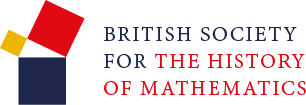Where would the world be without mathematics? Guidelines for entrants
Where would the world be without mathematics? Guidelines for entrants
Your entry
The British Society for the History of Mathematics (BSHM) invites you to explore the role of mathematics in society, today or in the past. Please communicate your findings in an accessible and engaging way. It could be a written article (maximum length 1500 words), a short video (maximum length 10 minutes) or some other multimedia presentation (maximum 10 minutes duration). You might consider a mathematical idea or concept, an interesting application of mathematics or the role of an individual mathematician — whatever it is, we want to hear about it! The level of mathematics is completely up to you. The hardest mathematics can be communicated in enlightening ways, and simple ideas can be interesting too. Your work could arise from your studies (e.g. a project for the International Baccalaureate or the Extended Project qualification) and this would be perfectly acceptable.
Researching your entry
Keep track of your sources, whether they are books, papers, interviews, or web pages. Provide the details of your sources in a bibliography, to be submitted with your entry. Include: title, author, publisher for books; author, title of article, title of periodical, volume and/or date for journal, magazine and newspaper articles; and the URL for websites, together with the date you accessed the site. If you interview someone, provide name, location and date of the interview. The Internet is likely to be a prominent source, but take special care with the information you find — make sure what you find can be substantiated from other sources. Check various sources and try to assess their respectability — for example articles published in peer-reviewed scientific journals or on university research group sites are probably reliable, but text appearing on people's personal homepages or blogs may not be. Try to base your final entry on a number of reliable sources and give these in your bibliography.
Preparing your entry
Entries should be no longer than 1500 words or ten minutes. Assume your audience has only a basic knowledge of mathematics and ensure it is accessible to someone aged 16 studying mathematics at school. Your entry should be clear, concise, informative and inspiring. Do use mathematical formulae and technical expressions if relevant, but make clear what they mean. If you need to include complex and abstracts ideas that are important to your topic, an example or analogy may be helpful. Images, diagrams and illustrations are welcome! Please include them in the appropriate place in your entry, with a number or caption. They should be of a reasonable quality to be reproduced on the internet. If you use diagrams, images or illustrations that are not your own, then get written permission for their use from the copyright holder. If they are from the Web, you can usually do this by emailing the contact person, if they are from a print publication, then write to the publisher. Prior to submission, get a person with no interest in mathematics whatsoever to experience your entry. He or she may have some very useful criticism. The judges will be interested not only in the content of your entry but also in the way you use language and media to bring it across. They will be looking for clear, lively and inspiring entries. Make sure that your entry is presented in English and that spelling and grammar are correct in a written article. Please note that we are unable to give advice on individual entries before they are submitted, as this would be unfair to others.
Submitting your entry
Include your name only on the electronic entry form; please do not include your name anywhere in the entry file(s). This is to ensure that judging is anonymous.
Your entry should be submitted electronically via www.bshm.ac.uk/plus as at most two files. Make sure that all illustrations and images, and the bibliography are included in the files.
The entry form will accept files up to 32MB in size. The accepted formats are: gif, jpg, png, eps, tif, html, pdf, rtf, doc, docx, odt, ppt, pptx, avi, mov, and mp3. If your entry is larger than 32MB, or if it is in a different format, please email plus@bshm.ac.uk for advice. Check that you have included your entry and bibliography.
Plagiarism
Plagiarism is stealing and passing off the ideas or words of another as your own, without crediting the source. Plagiarism is a serious offence! Do not copy any text, whether from the internet or a printed source, without clearly marking it as a quotation and stating where it is from. If you are paraphrasing the work from another source without significantly changing the content, you must also credit the source. Plagiarised entries will be disqualified and there is very reliable software for spotting such entries. As part of the entry form, you will be asked to confirm that the work you are submitting is original and your own work.
